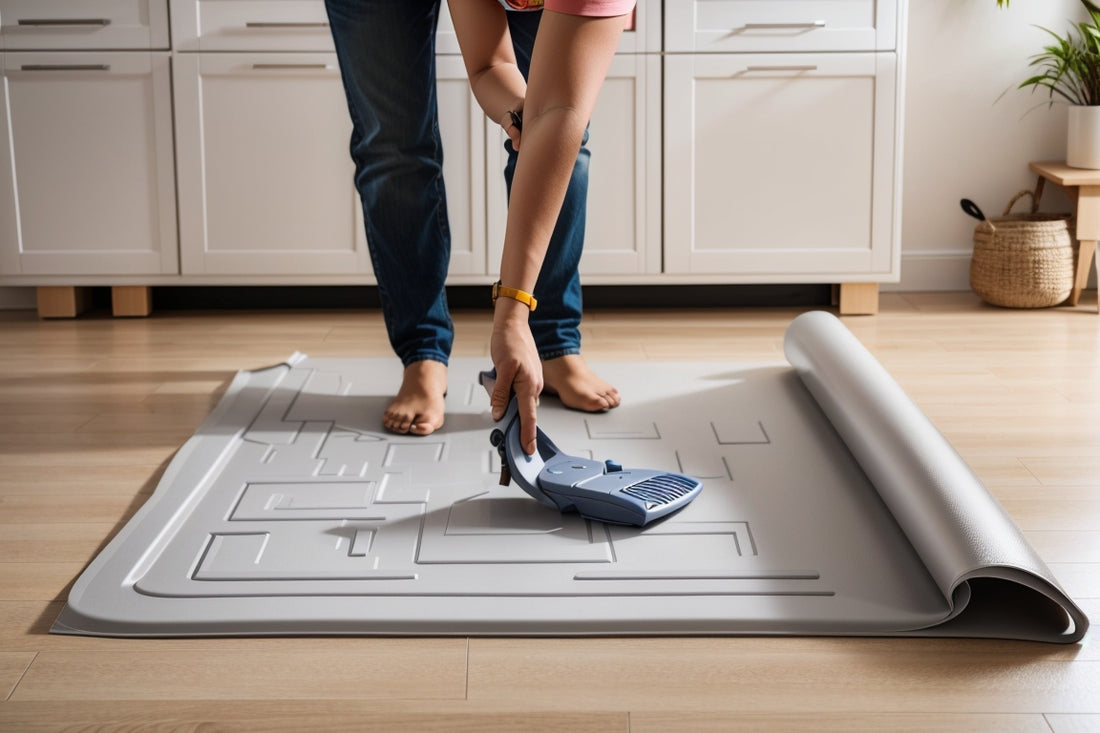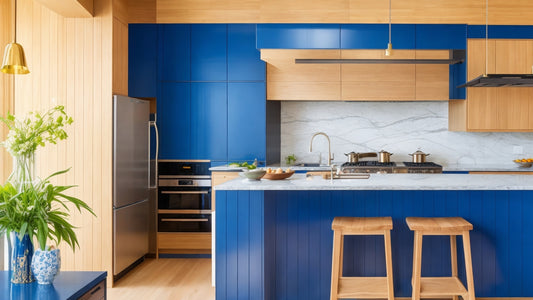Maximizing Kitchen Safety in Minutes: Installing Floor Mats

Share
How to Install Kitchen Floor Mats Safely
Kitchen floor mats are a great way to protect your floors from spills and stains, and they can also provide comfort and support while you're cooking and cleaning. But it's important to install kitchen floor mats safely to avoid slipping and tripping hazards.
Here are some tips on how to install kitchen floor mats safely:
- Choose the right mats. Not all kitchen floor mats are created equal. When choosing mats for your kitchen, look for mats that are made of a durable material and have a non-slip backing. You should also choose mats that are the right size for your kitchen and that are easy to clean.
- Prepare the floor. Before you install your kitchen floor mats, make sure that the floor is clean and dry. Remove any dirt, dust, or debris, and mop up any spills. You may also want to vacuum the floor to remove any loose fibers or pet hair.
- Place the mats in the right location. Place your kitchen floor mats in areas where you're most likely to stand for long periods of time, such as in front of the sink or stove. You should also place mats in areas where spills are likely to occur, such as in front of the dishwasher or refrigerator.
- Secure the mats. Once you've placed your kitchen floor mats in the right location, secure them in place so that they don't slip or move around. You can use double-sided tape or carpet tape to secure the mats. If you're using mats with a non-slip backing, make sure that the backing is clean and dry before you place the mats on the floor.
Here are some additional tips for safely installing kitchen floor mats:
- Avoid placing mats on stairs or in high-traffic areas. This can create a tripping hazard.
- Make sure that the mats are completely flat before you walk on them. Any creases or wrinkles in the mats can increase your risk of slipping.
- Clean your kitchen floor mats regularly. This will help to remove any dirt, dust, or spills that could create a slippery surface.
- Replace your kitchen floor mats when they become worn or damaged. Worn-out mats can be more slippery and may not provide as much support.
Benefits of installing kitchen floor mats safely
There are many benefits to installing kitchen floor mats safely. Here are a few:
- Prevents slips and falls. Slips and falls are a leading cause of injuries in the home, especially in the kitchen. Installing kitchen floor mats safely can help to prevent slips and falls, and keep you and your family safe.
- Protects your floors. Kitchen floor mats can help to protect your floors from spills, stains, and scratches. This can help to extend the life of your floors and save you money on repairs in the long run.
- Provides comfort and support. Kitchen floor mats can provide comfort and support while you're cooking and cleaning. This can help to reduce fatigue and discomfort, and make it easier to spend long periods of time in the kitchen.
Popular types of kitchen floor mats
There are many different types of kitchen floor mats available, each with its own unique benefits. Here are a few of the most popular types of kitchen floor mats:
- Anti-fatigue mats. Anti-fatigue mats are designed to provide comfort and support while you're standing for long periods of time. They are often made of a soft, cushioned material that helps to reduce fatigue and discomfort.
- Non-slip mats. Non-slip mats are designed to prevent slips and falls. They typically have a rubber or latex backing that helps to grip the floor.
- Stain-resistant mats. Stain-resistant mats are designed to resist spills and stains. They are often made of a durable, easy-to-clean material.
- Absorbent mats. Absorbent mats are designed to absorb spills and moisture. They are often made of a soft, absorbent material such as microfiber or cotton.
How to choose the right kitchen floor mats for your needs
When choosing kitchen floor mats for your needs, there are a few factors to consider:
- The size of your kitchen. Choose mats that are the right size for your kitchen. You don't want the mats to be too big or too small.
- The type of flooring you have. Choose mats that are compatible with the type of flooring you have. For example, if you have hardwood floors, you'll want to choose mats that won't damage the wood.
- Your budget. Kitchen floor mats can range in price from a few dollars to over $100. Choose mats that fit your budget and your needs.
How to clean and maintain kitchen floor mats
To clean and maintain your kitchen floor mats, follow the manufacturer's instructions. Most kitchen floor mats can be cleaned with a mild soap and water solution. However, some mats may require special cleaning products or methods.
Here are some general tips for cleaning and maintaining kitchen floor mats:
- Shake or vacuum the mats regularly. This will help to remove dirt, dust, and debris.
- Spot clean spills and stains immediately. The longer you wait to clean a spill or stain, the more difficult it will be to remove.
- Deep clean your mats regularly. The frequency of deep cleaning will depend on the type of mats you have and how often you use them. For example, anti-fatigue mats may need to be deep cleaned more often than non-slip mats.
To deep clean your kitchen floor mats, you can use a variety of methods, depending on the type of mats you have. Here are a few tips:
- Anti-fatigue mats. Most anti-fatigue mats can be deep cleaned with a mild soap and water solution. You can also use a steam cleaner to deep clean anti-fatigue mats.
- Non-slip mats. Non-slip mats can also be deep cleaned with a mild soap and water solution. You can also use a pressure washer to deep clean non-slip mats.
- Stain-resistant mats. Stain-resistant mats can typically be deep cleaned with a mild soap and water solution. However, you may need to use a special cleaning product to remove stubborn stains.
- Absorbent mats. Absorbent mats can be deep cleaned by soaking them in a mild soap and water solution. You can also use a washing machine to deep clean absorbent mats.
Once you have deep cleaned your kitchen floor mats, make sure to dry them completely before putting them back in place. Damp mats can create a slipping hazard.
Read More: Best Practices for Cleaning Kitchen Floor Mats
Tips for extending the life of your kitchen floor mats
Here are a few tips for extending the life of your kitchen floor mats:
- Clean your mats regularly. Regular cleaning will help to remove dirt, dust, and debris, which can damage the mats over time.
- Deep clean your mats regularly. Deep cleaning will help to remove stubborn stains and dirt, which can also damage the mats over time.
- Store your mats properly. When you're not using your mats, store them in a cool, dry place. Avoid storing them in direct sunlight or in hot or humid conditions.
- Replace your mats when they become worn or damaged. Worn-out mats are more likely to slip and move around, and they may not provide as much support.
By following these tips, you can safely install and maintain your kitchen floor mats, and extend their lifespan.
Additional tips for safely installing and using kitchen floor mats
- Make sure that the mats are completely flat before you walk on them. Any creases or wrinkles in the mats can increase your risk of slipping.
- Be careful when walking on wet or slippery mats. It's always best to dry your feet before walking on kitchen floor mats.
- Avoid placing mats in areas where they will be exposed to excessive heat or moisture. This can damage the mats and make them more likely to slip.
- If you have any pets, make sure to trim their nails regularly. Long nails can scratch and damage kitchen floor mats.






